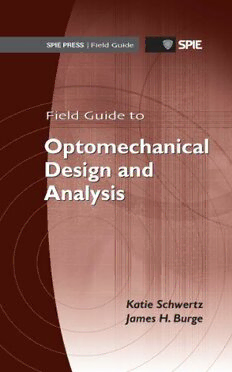
Field Guide to Optomechanical Design and Analysis PDF
Preview Field Guide to Optomechanical Design and Analysis
Field Guide to Optomechanical Design and Analysis Katie Schwertz James H. Burge SPIE Field Guides Volume FG26 John E. Greivenkamp, Series Editor Bellingham, Washington USA Downloaded From: http://ebooks.spiedigitallibrary.org/ on 12/04/2012 Terms of Use: http://spiedl.org/terms FFGG2266 ccoovveerrss aanndd ttiittllee..iinndddd 33 55//2211//1122 1100::3366 AAMM LibraryofCongressCataloging-in-PublicationData Schwertz,KatieM. Fieldguidetooptomechanicaldesignandanalysis/Katie M.Schwertz,JimH.Burge. p.cm.–(Thefieldguideseries) Includesbibliographicalreferencesandindex. ISBN978-0-8194-9161-9 1. Optical instruments–Design and construction– Handbooks,manuals,etc.2.Optomechanics– Handbooks,manuals,etc.I.Burge,JamesH.II.Title. TS513.S3852012 681.4–dc23 0 2012013233 Publishedby SPIE P.O.Box10 Bellingham,Washington98227-0010USA Phone:+1.360.676.3290 Fax:+1.360.647.1445 Email:[email protected] Web:http://spie.org Copyright © 2012 Society of Photo-Optical Instrumenta- tionEngineers(SPIE) Allrights reserved.Nopart ofthispublicationmay bere- producedordistributedinanyformorbyanymeanswith- outwrittenpermissionofthepublisher. The content of this book reflects the work and thought of theauthor.Everyefforthasbeenmadetopublishreliable and accurate information herein, but the publisher is not responsible for the validity of the information or for any outcomes resulting from reliance thereon. For the latest updatesaboutthistitle,pleasevisitthebook’spageonour website. PrintedintheUnitedStatesofAmerica. Firstprinting Downloaded From: http://ebooks.spiedigitallibrary.org/ on 12/04/2012 Terms of Use: http://spiedl.org/terms IntroductiontotheSeries Welcome to the SPIE Field Guides—a series of publica- tions written directly for the practicing engineer or sci- entist. Many textbooks and professional reference books cover optical principles and techniques in depth. The aim of the SPIE Field Guides is to distill this information, providing readers with a handy desk or briefcase refer- ence that provides basic, essential information about op- tical principles, techniques, or phenomena, including def- initions and descriptions, key equations, illustrations, ap- plication examples, design considerations, and additional resources. A significant effort will be made to provide a consistent notation and style between volumes in the se- ries. Each SPIE Field Guide addresses a major field of optical science and technology. The concept of these Field Guides is a format-intensive presentation based on figures and equations supplemented by concise explanations. In most cases, this modular approach places a single topic on a page,andprovidesfullcoverageofthattopiconthatpage. Highlights, insights, and rules of thumb are displayed in sidebars to the main text. The appendices at the end of each Field Guide provide additional information such as related material outside the main scope of the volume, keymathematicalrelationships,andalternativemethods. Whilecompleteintheircoverage,theconcisepresentation maynotbeappropriateforthosenewtothefield. The SPIE Field Guides are intended to be living documents. The modular page-based presentation format allows them to be easily updated and expanded. We are interested in your suggestions for new Field Guide topics aswellaswhatmaterialshouldbeaddedtoanindividual volume to make these Field Guides more useful to you. Pleasecontactusatfi[email protected]. JohnE.Greivenkamp,SeriesEditor CollegeofOpticalSciences TheUniversityofArizona FieldGuidetoOptomechanicalDesignandAnalysis Downloaded From: http://ebooks.spiedigitallibrary.org/ on 12/04/2012 Terms of Use: http://spiedl.org/terms FieldGuidetoOptomechanicalDesignand Analysis Optomechanics is a field of mechanics that addresses the specific design challenges associated with optical systems. This Field Guide describes how to mount optical components, as well as how to analyze a given design. It is intended for practicing optical and mechanical engineers whose work requires knowledge in both optics andmechanics. Throughout the text, we describe typical mounting approaches for lenses, mirrors, prisms, and windows; standard hardware and the types of adjustments and stages available to the practicing engineer are also included. Common issues involved with mounting optical components are discussed, including stress, glass strength, thermal effects, vibration, and errors due to motion. A useful collection of material properties for glasses, metals, and adhesives, as well as guidelines for tolerancing optics and machined parts can be found throughoutthebook. ThestructureofthebookfollowsJimBurge’soptomechan- ics course curriculum at the University of Arizona. We of- fer our thanks to all those who helped with the book’s de- velopment and who provided content and input. Much of the subject matter and many of the designs are derived fromtheworkofPaulYoderandDanVukobratovich;their feedbackisgreatlyappreciated. KatieSchwertz EdmundOptics® JimBurge CollegeofOpticalSciences UniversityofArizona FieldGuidetoOptomechanicalDesignandAnalysis Downloaded From: http://ebooks.spiedigitallibrary.org/ on 12/04/2012 Terms of Use: http://spiedl.org/terms v TableofContents ListofSymbolsandAcronyms ix ImageMotionandOrientation 1 OpticalEffectsofMechanicalMotion 1 LensandMirrorMotion 2 PlaneParallelPlate 3 GeneralImage-MotionEquations 4 ImageMotionExample 5 RigidBodyRotation 6 QuantifyingPointingError 7 ImageOrientation 8 MirrorMatrices 10 MirrorRotationMatrices 12 ConeIntersectingaPlane 13 Stress,Strain,andMaterialStrength 14 StressandStrain 14 Strain-vs-StressCurve 16 SafetyFactor 17 GlassStrength 18 StressBirefringence 20 PrecisionPositioning 22 KinematicConstraint 22 ExampleConstraintsandDegreesofFreedom 23 Semi-KinematicDesign 24 IssueswithPointContacts 25 PrecisionMotion 27 StageTerminology 28 LinearStages 29 RotationandTiltStages 30 ErrorsinStageMotion 31 PrecisionFasteningandAdjustments 32 StandardHardware 32 ExampleScrews 33 FastenerStrength 34 TighteningTorque 36 Adjusters 37 DifferentialScrewsandShims 38 LiquidPinning 39 ElectronicDrivers 40 Flexures 41 StiffnessRelationsforSingle-StripFlexures 42 FieldGuidetoOptomechanicalDesignandAnalysis Downloaded From: http://ebooks.spiedigitallibrary.org/ on 12/04/2012 Terms of Use: http://spiedl.org/terms vi TableofContents ParallelLeafStripFlexures 43 Stiffness Relations for Parallel Leaf Strip Flexures 44 NotchHingeFlexures 45 Adhesives 46 AdhesiveProperties 47 AdhesiveThicknessandShapeFactor 48 ThermalStress 49 ChoiceofBondSizeandThickness 50 MountingofOpticalComponents 51 LensMounts:OfftheShelf 51 LensMounting:Custom 53 CalculatingTorqueandClearance 54 PottingaLenswithAdhesive 55 ClampedFlangeMount 56 LensBarrelAssemblies 57 LensBarrelAssemblyTypes 58 Surface–ContactInterfaces 60 PrismTypes 62 Image-RotationPrisms 64 Image-ErectionPrisms 65 PrismandBeamsplitterMounting 66 Thin-WedgeSystems 68 WindowMounting 69 Domes 72 DomeStrength 73 Small-MirrorMounts:OfftheShelf 74 Small-MirrorMounts:Adhesivesand Clamping 75 Small-Mirror Mounts: Tangent Flexure and Hub 76 MirrorSubstrates 77 MirrorSubstrateExamples 79 Large-MirrorMounting:LateralSupports 80 Large-MirrorMounting:PointSupports 81 Large-MirrorMounting:ActiveSupports 82 Self-WeightDeflection:General 83 Self-WeightDeflection:ThinPlates 84 Self-WeightDeflection:ParametricModel 85 LightweightingMirrors 86 FlexuralRigidityofLightweightedMirrors 88 FieldGuidetoOptomechanicalDesignandAnalysis Downloaded From: http://ebooks.spiedigitallibrary.org/ on 12/04/2012 Terms of Use: http://spiedl.org/terms vii TableofContents DesignConsiderationsandAnalysis 89 RMS,P–V,andSlopeSpecifications 89 FiniteElementAnalysis 90 Vibration 94 DampingFactor 95 Isolation 96 SystemAccelerationandDisplacement 97 ThermalEffects 98 HeatFlow 100 AirIndexofRefraction 102 Athermalization 103 PassiveAthermalization 104 ActiveAthermalization 105 DeterminingThermallyInducedStress 106 Alignment 107 OpticalandMechanicalAxisofaLens 108 AlignmentTools 109 Tolerancing 110 GeometricDimensioningandTolerancing 110 GD&TTerminology 111 GD&TSymbology 112 ISO10110Standard 113 Appendices 114 ToleranceGuides 114 Clean-RoomClassifications 117 ShippingEnvironments:Vibration 119 ShippingEnvironments:DropHeights 120 UnitConversions 121 Cost and Performance Tradeoffs for Linear Stages 122 TorqueCharts 125 AdhesiveProperties 127 GlassProperties 130 MetalProperties 134 EquationSummary 136 Glossary 141 Bibliography 144 References 148 Index 149 FieldGuidetoOptomechanicalDesignandAnalysis Downloaded From: http://ebooks.spiedigitallibrary.org/ on 12/04/2012 Terms of Use: http://spiedl.org/terms ix ListofSymbolsandAcronyms %TMC Percenttotalmasslost %CVCM Percentcollectedvolatilecondensable material a Acceleration A Area CAD Computer-aideddesign COTS Commercialoff-the-shelf C Specificheatcapacity p CTE Coefficientofthermalexpansion CVD Chemicalvapordeposition d Displacement d Distance D Diameter D Thermaldiffusivity D flexuralrigidity E Young’smodulus f Focallength F Force,load f0 Naturalfrequency(Hz) FEA Finiteelementanalysis FEM Finiteelementmethod g Gravity(9.8m/s2) G Shearmodulus GD&T Geometricdimensioningandtolerancing h Height,thickness IR Infrared k Stiffness K Bulkmodulus K Fracturetoughness c K Stressopticcoefficient s l Length L Length LMC Leastmaterialcondition LOS Lineofsight m Magnification m Mass MMC Maximummaterialcondition MoS Marginofsafety n Indexofrefraction NA Numericalaperture NIST NationalInstituteofStandardsand Technology FieldGuidetoOptomechanicalDesignandAnalysis Downloaded From: http://ebooks.spiedigitallibrary.org/ on 12/04/2012 Terms of Use: http://spiedl.org/terms
